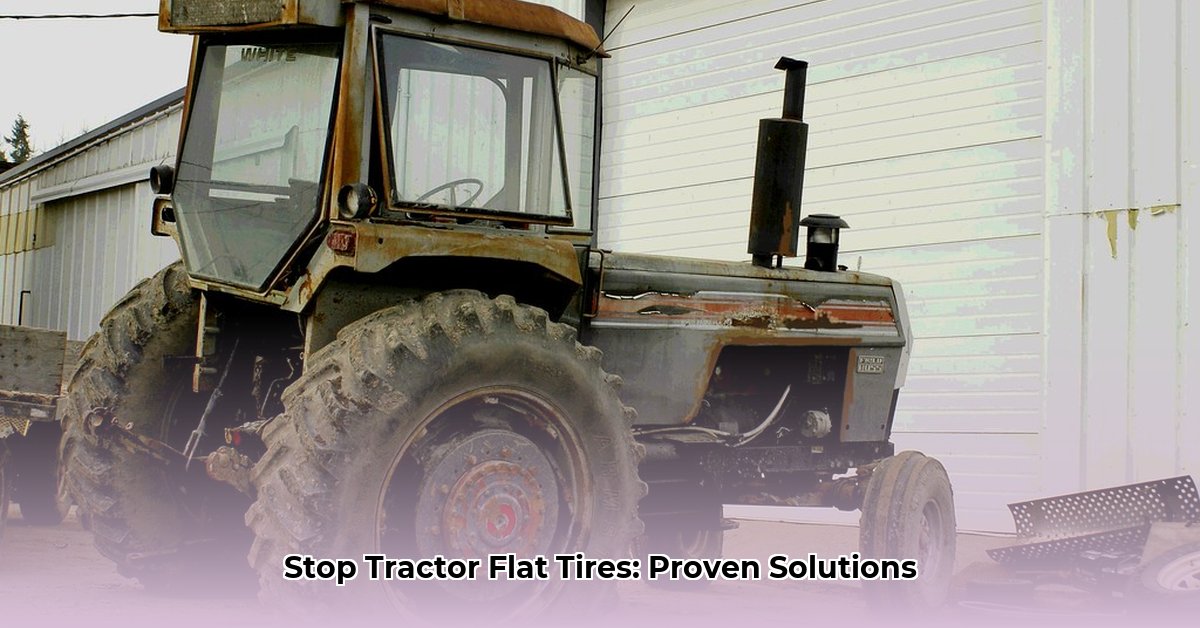
Flat tractor tires lead to costly downtime and reduced productivity. Proactive prevention is crucial. This guide compares leading flat tire prevention methods, helping you choose the best solution for your operation's specific needs and budget. We'll cover air-filled tires, liquid sealants, foam filling, polyurethane liners, and aircraft tires, examining the pros, cons, and implementation details of each. For more on tire sealant options, check out this helpful resource: learn more.
Understanding the Problem
A flat tractor tire isn't just inconvenient; it disrupts workflows, leading to lost time and money. Repairing or replacing tires adds to operational expenses. Avoiding these issues through preventative measures is a smart, cost-effective strategy.
Comparing Tire Solutions
Several methods effectively reduce or eliminate flat tires. The optimal choice depends on factors such as budget, tractor type, usage intensity, and terrain.
1. Air-Filled Tires (Standard)
The most common, but also the most vulnerable to punctures. Regular pressure checks and prompt attention to even minor damage are essential.
- Pros: Low initial cost, readily available parts and service.
- Cons: High puncture risk, requires frequent maintenance. Don't underestimate the ongoing cost of repairs, which can quickly erase any initial savings.
2. Liquid Sealant
This sealant automatically seals small punctures. It's a budget-friendly option for occasional punctures, particularly in relatively clean environments. However, it's not a long-term solution for consistently rough terrain.
- Pros: Relatively low cost, easy application.
- Cons: Ineffective against larger punctures; requires periodic replenishment. Its effectiveness diminishes in harsh conditions.
3. Foam Filling
Foam completely replaces tire air, offering significant puncture resistance. However, the added weight can impact fuel efficiency and increase stress on tractor components. Professional installation is typically required.
- Pros: Superior puncture resistance.
- Cons: Substantial weight increase, higher initial investment, more difficult repairs. Consider the long-term effects of added weight on fuel consumption and mechanical wear.
4. Polyurethane Liners
These durable liners, installed inside tires, provide outstanding puncture protection. They are strong and long-lasting, but installation is complex and requires specialized tools. Removal is also difficult.
- Pros: Exceptional puncture resistance, extended tire lifespan.
- Cons: High initial cost, specialized installation needed, difficult removal. This represents a significant, long-term commitment.
5. Aircraft Tires
Built for extreme conditions, these heavy-duty tires offer exceptional flat resistance. They are ideal for harsh environments but are heavier and far more expensive than other options. Suitability depends heavily on the tractor and terrain.
- Pros: Extreme puncture resistance, suitable for demanding conditions.
- Cons: Significantly higher cost, added weight may negatively impact tractor performance. Careful consideration of weight capacity is critical.
Choosing the Right Method
The optimal solution depends on several key factors:
Budget: Some methods have higher upfront costs but might save money in the long run by reducing downtime and repairs. Consider the total cost of ownership over the tire's lifespan.
Tractor Type and Usage: A small utility tractor used infrequently has different needs than a large, heavy-duty machine operating daily in demanding conditions.
Terrain: Rocky, uneven terrain demands more robust protection than flat, smooth fields.
The following decision tree can assist:
Occasional flats, limited budget: Liquid sealant might suffice.
Frequent flats, moderate budget: Foam filling could be a better choice, bearing in mind the weight increase.
High puncture resistance needed, higher budget: Polyurethane liners or aircraft tires may be most suitable.
Always consult your tractor's manufacturer recommendations before implementing any method.
Implementation and Maintenance
Each method has specific installation requirements and maintenance needs. Prioritize safety; follow manufacturer instructions carefully, or consult a qualified mechanic if uncertain. Improper installation poses safety risks and potential mechanical issues.
Risk Assessment Matrix
| Method | Puncture Resistance | Weight Increase | Cost | Maintenance | Risk of Component Damage |
|---|---|---|---|---|---|
| Air-Filled | Low | None | Low | High | Low |
| Liquid Sealant | Moderate | Minimal | Low | Moderate | Low |
| Foam Filling | High | High | Moderate | Moderate | Moderate |
| Polyurethane Liners | Very High | Moderate | High | Low | Low |
| Aircraft Tires | Very High | High | High | Low | Low |
Further Considerations
New tire materials and designs are constantly being developed. Stay updated on advancements and regulatory changes that may influence your choices. Preventative maintenance – regular tire inspections and prompt repairs – remains your best defense against costly flat tires.
Key Takeaways
- Multiple methods exist for preventing flat tractor tires, each with advantages and disadvantages.
- The ideal solution depends on budget, tractor use, and terrain conditions. A thorough assessment of your specific needs is essential.
- Regular tire inspections and proper inflation are critical for minimizing flat tire occurrences. Consider this part of your standard farm maintenance routine.